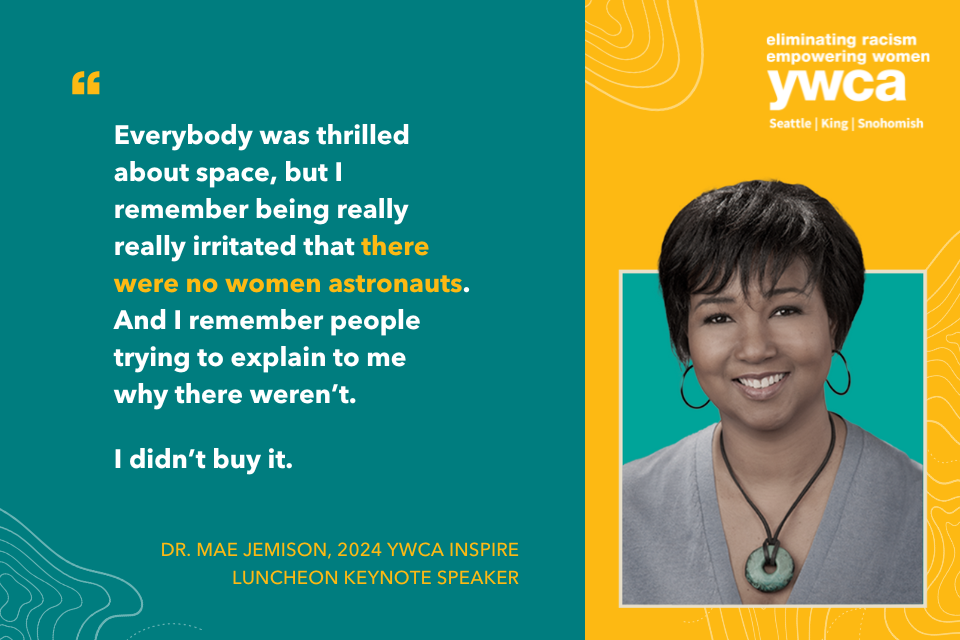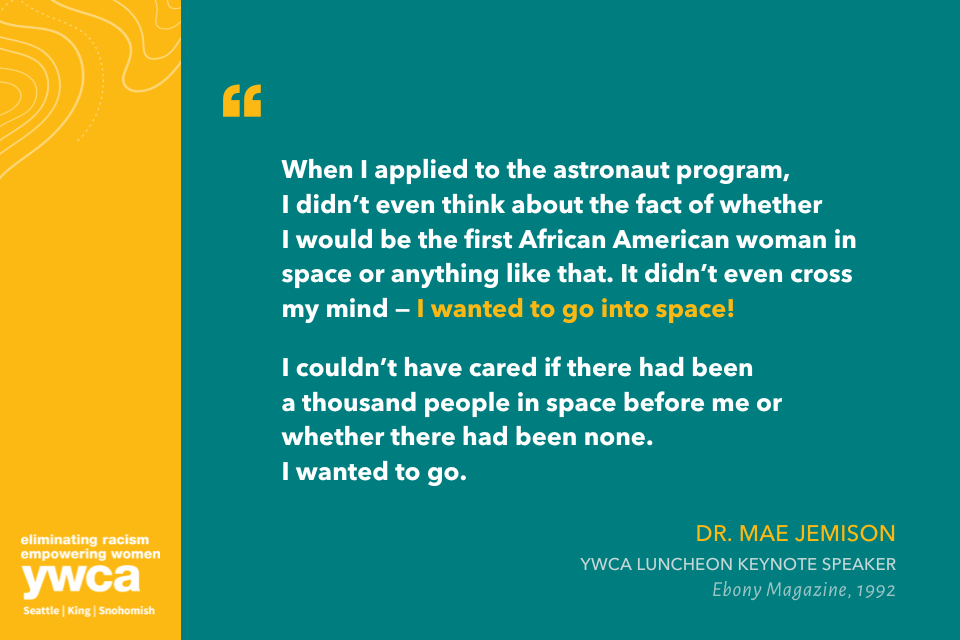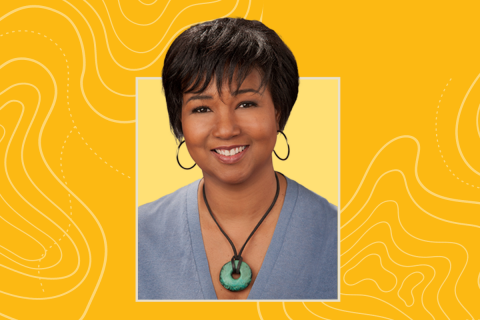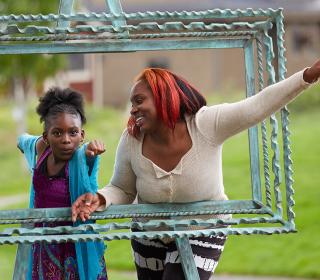2024 Luncheon
For over 130 years, YWCA has been dedicated to eliminating racism, empowering women, and fighting for the rights of our community and beyond so everyone has the opportunity to thrive.
We know that barriers to resources and a lack of mentors, role models, and supportive networks can make it difficult for BIPOC women to succeed and thrive. To combat this, we offer programs like Femme2STEM to help young BIPOC women and girls advance in STEM (science, technology, engineering, and math). We aim to educate and inspire our students so they have the ability to pursue their dreams and follow in the footsteps of this year's Luncheon keynote speaker, Dr. Mae Jemison.
About Dr. Mae Jemison
NASA astronaut, engineer, physician, dancer, professor — Dr. Mae Jemison is all these things and more. Born in Alabama in 1956 and raised in Chicago, Dr. Jemison grew up with a strong interest in the arts and sciences. Even at a young age, Dr. Jemison already had a desire to someday go to space, but seeing the lack of women astronauts during the Apollo mission frustrated her.

Dr. Jemison was determined she would go to space, stating it as a certainty rather than a hope or wish. Although her parents were very supportive of her goals, not everyone was. “In kindergarten, my teacher asked me what I wanted to be when I grew up, and I told her a scientist. She said ‘Don’t you mean a nurse?’ Now, there’s nothing wrong with being a nurse, but that’s not what I want to be.” (Ebony Magazine)
Dr. Jemison’s ambitions led her to Stanford University at the age of 16, where she pursued her interest in both science and dance. But being one of the few non-white students in her courses, Dr. Jemison faced discrimination from her professors. “Some professors would just pretend I wasn't there. I would ask a question and a professor would act as if it was just so dumb, the dumbest question he had ever heard. Then, when a white guy would ask the same question, the professor would say, ‘That's a very astute observation.’” (The New York Times) In response to this, Dr. Jemison joined the Black Students Union, later becoming the head of the organization, and choreographed a musical dance production called Out of the Shadows, which highlighted the experience of African Americans.
After struggling to decide between going to medical school or pursuing a career as a professional dancer, Dr. Jemison graduated from Stanford in 1977 with a Bachelor’s degree in Chemical Engineering and African American studies and attended Cornell University Medical College, where she earned her M.D. In 1983, she served in the Peace Corps for two years in Liberia and Sierra Leone. After returning home in 1985, Dr. Jemison applied to NASA’s astronaut program and in 1987, she was one of 15 people chosen out of over 2,000 applications.
A journey to the stars
After many years of training and work with NASA, on September 12, 1992, Dr. Jemison and six other astronauts went into space on the space shuttle Endeavor. With her, Dr. Jemison brought a poster of Judith Jamison performing the dance “Cry,” dedicated to all Black women everywhere, a Bundu statue from the women’s society in Sierra Leone, a flag for the Alpha Kappa Alpha sorority, the oldest African American women’s sorority in the United States, and a certificate for the Chicago Public School students to work to improve their science and math. To her, these items not only represented human creativity, they also represented people who were often not included or represented.

One of the first things Dr. Jemison saw in space was her hometown Chicago, and she imagined how pleased her younger self would be seeing how far she had come. “In space, I was very comfortable, calm. I felt like I had a right to be anywhere in this universe, that I belong here and that I am as much a part of the universe as any speck of stardust, comet, star or planet.” (CNN) That perspective of belonging was important to her.
After serving as an astronaut for six years with over 190 hours logged in space, Dr. Jemison left NASA in 1993 to start The Jemison Group, a consulting firm that encouraged science, technology, and social change. She taught environmental studies at Dartmouth College, directed the Jemison Institute, which facilitated research, design, implementation, and evaluation of advanced technology for sustainable development in less-industrialized nations, and worked on 100 Year Starship, a joint project between NASA and the U.S. Defense Advanced Research Projects Agency with a goal of making interstellar flight a possibility in the next century.
Where no woman has gone before
In her youth, Dr. Jemison's desire to go to space was reinforced by Star Trek and the portrayal of Lieutenant Uhura, played by Nichelle Nichols. For Dr. Jemison, Star Trek was inspiring not only because of its narrative of advanced science and space travel, but also for the groundbreaking representation it had. “I’ve loved science fiction because it allows you to look at people and societies from a different perspective. Star Trek was one of our most hopeful fantasies. It had people from all around the world on the bridge of the ship! It even had an alien, and it had a woman of color in a technical role – Nichelle Nichols, who played Lieutenant Uhura. It helped me to say ‘Yes, this is something that’s reasonable to think about.’” (PBS SoCal)

(OfficialNichelleNichols | San Francisco Chronicle)
During her first space flight, Dr. Jemison used Lieutenant Uhura’s trademark phrase “hailing frequencies open” to begin communication. She had the opportunity to meet her idol at a Star Trek convention in Orlando Florida, where they became fast friends. In 1993 shortly after retiring from NASA, Dr. Jemison starred in an episode of Star Trek: The Next Generation playing the role of Lieutenant Palmer. “It was a very cool experience, because in many ways, it was coming full-circle. [...] I got to come back around and help to verify that yes, this happens.” (WETA)
Register for our September 19 Luncheon to hear more from Dr. Mae Jemison, and sign up for our newsletter to stay informed with YWCA’s race and social justice work!
Ana Rodriguez-Knutsen is the Content Specialist for YWCA's Marketing & Editorial team. From fiction writing to advocacy, Ana works with an intersectional mindset to uplift and amplify the voices of underrepresented communities.
We share the stories of our program participants, programs, and staff, as well as news about the agency and what’s happening in our King and Snohomish community.

